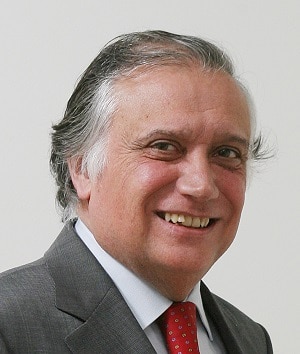Global Finance’s Best Banks in Western Europe 2020 distinguished themselves by strengthening their capital buffers—just in time for a wrenching new year.

CaixaBank repeats this year as Global Finance’s Best Bank in Western Europe, on the strength of its position as the most successful retail lender in the Iberian Peninsula and a leading exponent of customer-friendly digital innovation. It extended its leadership across key market segments and increased its underlying earnings, while further reducing its nonperforming loans and strengthening capital buffers.
That places CaixaBank in a stronger position to survive the very different world of 2020. Its home market, Spain, has been one of the hardest hit by Covid-19, which makes its position in the economy even more crucial. “Now, more than ever, the banking sector is proving necessary in times of need to sustain the economy, help companies keep their operations up and running and support families in a vulnerable situation,” says CEO Gonzalo Gortázar. “It is now when our growth levers take on their true meaning for us.”
In March, CaixaBank launched an initiative to curb the economic and social effects of the coronavirus and was the first European bank to reduce its 2019 dividend and payout. It also decided to reduce its capital target for 2020, prioritizing instead its capacity to increase lending as needed.
 Gonzalo Gortázar, CEO of CaixaBank |
“We offered a €25 billion [$27 billion] facility of preapproved loans to 440,000 self-employed workers, 115,000 microenterprises and 52,000 small enterprises,” says Gortázar, “and we deployed a wide range of initiatives to stand by the elderly, homeowners, small retailers, vulnerable families, our employees, healthcare personnel and society as a whole.”
CaixaBank is well positioned to take a leading role. It is the primary bank for nearly a quarter of all Spaniards. It has achieved 30% market penetration among digital clients, thanks in part to innovations like imaginBank, the country’s first mobile-only bank. It continued to gain market share across key segments last year, including mutual funds and savings, where assets under management grew 6.3%; and pension plans, which saw 14.7% growth.
The bank’s loans and deposits climbed by 4.7% to nearly €612 billion in 2019, and proactive management helped reduce nonperforming loans (NPLs). The NPL ratio dropped by 108 basis points to 3.6%. Total core revenues increased 1.2% to €8.3 billion. Underlying group earnings climbed 20.4% to €2.4 billion, with a 10.8% return on equity (ROE); although after adjusting for a €978 million labor agreement, the bank’s net profit came in 14% lower than in 2018. Its tier-one capital ratio improved to 12% at year-end.
CEO Gortázar highlights the bank’s “digital transformation, with improvements in internal processes and in digital channels to accompany the clients whenever and wherever they are,” alongside the “strengthening of our capital and liquidity position.”
UK, Ireland
Combining a major presence in domestic retail and commercial banking with a global investment bank that is better equipped than most of its European peers to compete with the Wall Street giants, Barclays takes the title as Best Bank in the UK. Both divisions contributed to an overall 25% increase in group income in 2019, to £21.6 billion ($26.77 billion).
Barclays UK is cutting costs through branch closures and the expansion of its digital channels, which resulted in a 2% reduction in operating expenses last year. Squeezed margins caused net interest income to drop by 2% to £5.9 billion, however, even as the bank increased lending to customers by 3.3%. Fee and commission income was up 8%, and underlying profit before tax rose by 7% to £2.6 billion. The bank’s tier-one capital ratio strengthened to 13.8% at year-end. However, heavy litigation and conduct provisions hit the bottom line hard at Barclays UK, which reported a 48% decline in pretax profit.
This year, Barclays launched a £100 million community-aid package in response to the Covid-19 crisis, the funds going to charities working to help vulnerable people. Top executives will donate a third of their fixed pay over the next six months.
Barclays nevertheless is keeping its eye on the future, which it increasingly regards as digital. “Looking ahead … we will accelerate our digital journey and continue to play a leading role in capturing innovation and bringing it to life, at scale, for millions of customers and clients,” said Group CEO Jes Staley in a statement announcing the bank’s 2019 results.
Allied Irish Bank (AIB) is this year’s Best Bank in the Republic of Ireland after generating an underlying pretax profit of nearly €1.1 billion despite lower net interest margins and the negative impacts of the Brexit drama on the Irish economy. AIB’s performing loan book grew by 3% across all asset classes, with a 2% increase in new lending. “We improved our customer proposition and streamlined service to our 2.8 million customers,” said AIB Group CEO Colin Hunt in a March statement, “whilst increasing our new lending to €12.3 billion to support economic growth.”
The bank reduced its NPL exposure in 2019 by 45% to €3.3 billion, representing 5.4% of gross loans, thanks in part to the sale of two portfolios in deep arrears and a 14% tier-one capital adequacy ratio that was comfortably above regulatory requirements at the end of the year. Large exceptional charges, including €300 million of additional provisions to meet potential liabilities arising from involvement in tracker mortgages, impacted the bottom line as pretax profit dropped by 60% to €499 million.
France, Monaco
Credit Mutuel, this year’s Best Bank in France, has built commercial momentum on an alliance of regional banking and insurance networks; during 2019, nearly 95% of lending decisions were taken locally. Likewise, Credit Mutuel’s private equity subsidiary, which manages a €2.6 billion portfolio, invested €422 million in startups and small to medium-sized enterprises across the country. Customer numbers increased by 5.5% to more than 26 million, and customer deposits rose by 11.4% over the year. Meanwhile, the bank further strengthened its capital buffers, with its tier-one ratio standing at 17.3% at year’s end.
The combination of business expansion and prudent capital moves enabled Credit Mutuel to raise its net profit above €3.1 billion, an improvement of more than 5% over 2019. Net banking income came in 3.5% higher at €14.6 billion on the back of a 6% increase in lending and tightly contained costs.
Our winner in Monaco, CFM Indosuez Wealth, increased revenues by 14.5% on the back of a 6% rise in net income. Costs rose marginally, as investment in its digital transformation accelerated. While CFM’s main income streams still derive from wealth management, it also maintains the largest physical retail banking presence in the principality.
The Southern Tier
UniCredit, our Best Bank in Italy, saw underlying net profit surge 55.5% in 2019, as the benefits of cost cutting and a sharp reduction in NPLs fed through to the bottom line. UniCredit’s home division, Commercial Banking Italy, generated an 11.3% increase in net operating profit to €2.3 billion on the back of stable revenues and a 6.1% reduction in costs. Net interest income declined 3.8% due to pressure on margins, including deposits; but fee income grew, thanks to strong insurance sales, helping to raise transaction fees nearly 6%. The bank further reduced its overall NPL ratio to 5.1% and posted a net profit of €1.4 billion, an improvement of 6.1% on the previous year.
UniCredit officials underscore that the bank’s numbers still look comparatively healthy, given the economic crisis engulfing Italy and other major economies. Group CEO Jean Pierre Mustier, who has led the turnaround at UniCredit, in announcing the group’s 2019 financial results, cited a solid balance sheet and a tier-one ratio of 13.09%. In March, the bank announced that its top executives have decided to waive their entire bonus for 2020 and contribute the equivalent amount to the UniCredit Foundation to support social initiatives, “considering the uncertain impact on the European economy of the current Covid-19 epidemic and its evolution over the next months.”
 In Memoriam: He was among the first victims of the novel coronavirus in his country, Portugal, and certainly among the more prominent from the banking world. Antonio Vieira Monteiro, chairman of Santande Totta, passed away in March. The 73-year-old banker had been chairman of the Portuguese unit of Santander since 2019, after seven years as CEO. |
Portugal’s Banco Santander Totta celebrated its best year ever domestically in 2019, achieving net income of €527 million, a 5.5% expansion over the previous year. Operating income increased 7%, reflecting growth in commissions, insurance business and net income from financial operations. The bank’s NPL exposure ratio decreased to 3.3%, well below the sector average. With profits growing, ROE rose 12.4%.
Santander Totta appears well placed to withstand the pressures of this pandemic year, with high liquidity and capitalization levels and a tier-one ratio of 15.2%, 1.2 percentage points higher than at the end of 2018.
Credit Andorra, the leading bank in the Pyrenean principality by business volume and profitability, achieved a net profit of €46.24 million in 2019. Major investments in technological innovation include Merkaat, Andorra’s first fully digital investment-fund adviser; the use of a biometric signature for authorization of in-branch transactions; and the bank’s Crèdit Wallet mobile payment service. Credit Andorra’s liquidity and solvency ratios both comfortably exceed required levels.
Our winner in Greece, Eurobank Ergasias, has moved ahead of its peers in improving its liquidity position. Last year was “a milestone year for the bank, as we have delivered on our accelerated NPE (nonperforming exposures ) reduction plan,” said CEO Fokion Karavias in March, noting that the bank has, over the last three years, increased its capital adequacy ratio by close to 400 basis points, reduced nonperforming loans from roughly 46% to 16%, and enhanced its liquidity position with some €13 billion more in deposits, €9 billion in Greece. “Eurobank has addressed all key legacy issues,” he concluded.
While net interest income came down slightly, Eurobank’s fee and commission income grew by 13.6% year-on-year. Proactive management helped reduce operating costs in Greece by 1.6% and loan loss provisions fell by 8.3%. Customer deposits grew by €5.8 billion and the stock of performing loans increased significantly, all contributing to a 26.8% leap in the bank’s net profit and further strengthening its capital buffers. Its tier-one ratio stood at 16.7% at year’s end.
In Greece’s neighbor, Cyprus, Hellenic Bank performed well ahead of its Cypriot competitors in deleveraging and rationalizing its NPLs. The bank’s latest figures show pretax profit hitting €89 million as it met rising credit demand from all segments of a fast-improving economy. Hellenic Bank’s share of total lending on the island rose sharply in 2019.
After integrating the assets of Cyprus Cooperative Bank that it purchased in 2018, “we can focus all our efforts to grow the bank and to enhance the franchise within a sound control and governance framework,” said CEO Yannis Matsis in a statement announcing third-quarter 2019 results. Hellenic Bank enjoyed a strong liquidity position at the end of September, with deposits accounting for nearly 90% of all assets and a tier-one ratio of 19%. However, the possible impacts of Covid-19 on the Cypriot economy prompted Fitch Ratings to issue a downgrade from B+ to B; although this still leaves Hellenic Bank a notch above its nearest competitor.
HSBC Malta moved on from its retrenchment strategy last year, which had resulted in a smaller but stronger business, to expand lending by 5%—most of the growth coming from retail customers. The quality of its loan book continued to improve as HSBC Malta reduced NPEs by 13% over 2018. Underlying profit before tax increased by 24%, and customer deposits were up by 5%, contributing to the bank’s strong liquidity position with a loan-to-deposits ratio of 65%. Driving performance was “revenue growth in retail banking, excellent progress on cost management and a low level of expected credit losses,” CEO Andrew Beane said in a February statement. HSBC Malta’s capital ratios continued to improve, with tier-one increasing from 14.6% to 16.4% by the end of 2019.
Germany, Austria
DZ Bank Group emerged as the 2020 Best Bank in Germany, having nearly doubled its pretax profit to €2.7 billion thanks to strong operational performance across its core entities and targeted bolt-on acquisitions. While net interest income was slightly down, fee and commission income rose and brisk capital markets business generated a net gain of €472 million. Post-merger synergies and effective cost management left overall expenses virtually unchanged and the bank’s cost/income ratio fell sharply to 57% despite fresh capital expenditure aimed at future growth.
“We significantly strengthened our capital base in 2019,” said Cornelius Riese, co-CEO of DZ Bank’s Strategy & Group Development,at the bank’s annual press conference in February. “We are in an ideal place to pursue our growth strategy, thanks to the strength of our balance sheet,” which he attributed to profit retention, careful management of the bank’s risk-weighted assets and a €1.4 billion AT1 debt issue. “Measured in terms of our growth objectives and against our competitors, both our common equity tier-one capital ratio [14.4%] and our leverage ratio are at a very solid level.”
Austria’s Best Bank, BAWAG Group, posted another record year, raising pretax profit by 6% to €604 million on a 5% increase in net interest income and a disciplined approach to cost management. Core revenues increased 3% and net fee and commission income was stable at €284 million. And while operating costs rose as a result of recent acquisitions, BAWAG’s overall cost-to-income ratio was down 1.5 percentage points to 42.7%, below the target it had set for 2019.
“The market environment for European financials continued to be challenging; however, the fundamentals of the Group remained strong,” CEO Anas Abuzaakouk said in a February press release. Earnings per share were up 19% at BAWAG compared to 2018, raising return on common equity to 16.1%. Taking into account a recent €400 million share buyback and a proposed 20% hike in dividend payments, BAWAG’s fully loaded tier-one ratio fell slightly to 13.3% by year’s end. Fitch rates BAWAG A-, but recently placed it on negative outlook due to expected impacts of Covid-19.
Switzerland, Lichtenstein
Wealth management and its associated activities, rather than interest income from banking, tend to be the main drivers for banks in Europe’s low-tax jurisdictions. This is especially true at a time when ultralow or negative interest rates are the norm. Our Best Bank in Switzerland, Credit Suisse, benefited from former CEO Tidjane Thiam’s strategy of cost-cutting combined with a strong focus on wealth management, handing the overall group a 40% increase in pretax profit in 2019.
Credit Suisse posted a strong performance in its home market. Pretax income rose 27% to 2.7 billion Swiss francs ($2.76 billion), driven by higher revenues and a further 3% decrease in operating expenses. Private clients generated 1.4 billion francs in income, up 30% year-on-year; while corporate and institutional clients generated a 24% increase to 1.3 billion francs, although net interest income and recurring commissions and fees were slightly down for the year. The group’s tier-one capital adequacy ratio improved to 12.7%.
“Our business strategy is expected to remain unchanged,” CEO Thomas Gottstein confirmed in a statement accompanying the bank’s report of its 2019 results.
In Switzerland’s tiny neighbor Liechtenstein, LLB Group produced sparkling results in 2019, its 45% spike in net profit to 123.4 million francs fueled by higher business volumes and a record inflow of new money. LLB’s investment fund business was a key driver of growth, with client assets under management rising 13.4% to 76.3 billion francs; although client loans increased only marginally to 13 billion francs. The bank’s tier-one ratio strengthened to 19.6% by year’s end. “Thanks to broad diversification and targeted acquisitions, we have significantly improved our earning power and quality. And we have achieved this in spite of a very challenging market environment,” said Group Chair Georg Wohlwend in announcing the group’s 2019 results.
The Low Countries
Ultralow interest rates and squeezed margins impacted the profitability of Belgium’s banks in 2019; and our country winner, BNP Paribas Fortis, was no exception. While loan volumes increased 4.4%, with strong growth in lending to corporate customers, net interest income fell 3%, as did operating income, which declined to just over €1 billion. Deposits ended the year 5% higher and mutual fund volumes rose nearly 13% over the year. Operating expenses shrank 1.6% thanks to branch closures and other proactive cost-cutting measures. Although fee income was up and costs contained, BNP posted a lower pretax income of €929 million.
Our Best Bank in the Netherlands, ING Group, saw its domestic retail arm post a pretax profit of €537 million, up 6.3% from 2018, mainly due to a lower cost of risk. Underlying income was down slightly as tighter margins on savings and current accounts reduced net interest income. This was largely offset by higher income from lending and especially by improved margins on mortgages, together with stronger revenues from treasury-related activities. ING Group was able to contain operating expenses despite higher regulatory costs—including anti-money laundering measures—but overall pretax profit came in 9.2% lower than the previous year.
“Pricing discipline and growth helped counter the pressure of negative interest rates,” said Group CEO Ralph Hamers, explaining the decline, in his statement accompanying the report of 2019 results. ING’s underlying ROE for the full year was 9.4%, however; and its tier-one ratio remained strong at 14.6%. Hamers will take up the post of group CEO of UBS in September.
State-owned BCEE, this year’s winner in Luxembourg, has by far the largest branch network and the greatest number of customers in the grand duchy. Its capital ratio stood at just over 21% at the end of last year. Both lending volumes and deposits grew by nearly 5% at BCEE in 2019. Despite a squeeze on net interest margins, the bank increased operating income 12.4% over the previous year. Costs rose 4.2% as BCEE reformatted branches. Meanwhile, its digital offering expanded with the launch of Spuerkeess Direct, fully digitized lending, Apple Pay and S-Net, the country’s open platform.
The Nordics
SEB is 2020’s Best Bank in Sweden, where nearly two-thirds of its overall revenues are generated. Despite prevailing ultralow interest rates and strong pressure on margins, particularly for household mortgages, SEB increased its net interest income last year on the back of increased lending to both corporate and private customers. As a result, both total operating income and underlying profit rose 9% in 2018.
SEB’s Markets and Treasury divisions generated higher financial income from volatile interest rate markets and were well positioned at year-end. Overall, the cost base rose by 3%; and after charges, reported operating profit came in at 14.1 billion Swedish kronor ($1.4 billion), down from 17.5 billion kronor the previous year. While SEB’s ROE fell to 13.7%, its tier-one ratio improved to 20.8% at year-end as the bank further strengthened its capital buffers.
Nordea is our winner in Denmark, where its household mortgage lending volume rose 3% and corporate lending held steady. Personal and corporate deposits increased by 3% and 6%, respectively; but narrower margins for both lending and savings products resulted in a 1% drop in net interest income. Net fee and commission income jumped by 14% in local currency terms. Nordea’s loan losses from personal banking doubled to €52 million, but provisions on business lending were unchanged. Nordea reinforced its capital base, ending the year with a tier-one ratio of 16.3%.
Norway’s largest bank, DNB, put in a strong performance in 2019 as corporate investment surged and demand for both mortgages and savings products grew rapidly. “Increased activity in all segments led to a lending growth of more than 50 billion Norwegian kroner [$4.68 billion],” noted CEO Kjerstin Braathen in announcing the bank’s annual results. The bank raised its underlying profit before tax and impairments more than 10% to 31.7 billion kroner. As Norwegians are saving more, DNB responded by reducing prices on its mutual funds and further developing its Spare savings apps.
“We have seen a digital savings revolution over the past year,” said Braathen, adding that DNB “sold mutual funds for 2 billion kroner in the Spare app alone. This is a larger turnover than most players in the market have on all their platforms combined.” Total fees and commissions rose 4.4%, DNB’s cost/income ratio improved to 42.2% and the bank strengthened its capital buffers, its tier-one capital adequacy ratio rising to 18.6% at year-end.
The most pan-Nordic of Scandinavian banks, Nordea is also our winner this year in Finland, having moved its group headquarters there to be within the eurozone and under European Central Bank regulation. Nordea increased its mortgage lending by 3% while reining in consumer loans, resulting in 2% growth in overall lending volume. Household deposits increased by 5%, but lower deposit and lending margins resulted in a 4% decrease in net interest income.
In Iceland, Landsbankinn achieved a net profit for 2019 of 18.2 billion Icelandic kronur ($123 million), slightly down from the previous year. ROE came in at 9.2% discounting the bank tax, which is close to the bank’s 10% target. Landsbankinn strengthened its capital buffers, boosting its total capital ratio 1% to 25.8% at year-end. CEO Lilja Björk Einarsdóttir stresses the importance of customer relationships; and early this year, Landsbankinn took the top spot in the Icelandic Performance Satisfaction survey.
“Landsbankinn has made major advances that are reflected in increased customer satisfaction and a strong market position, along with robust and sound operation,” said Einarsdóttir in presenting the bank’s 2019 financial results. “Increased optimization and ongoing restrictive measures are the main reasons behind nigh on stable operating costs year-over-year.” The bank’s cost-income ratio decreased considerably to 42.6% over the year.
Western Europe Winners |
|
|---|---|
| Andorra | Credit Andorra |
| Austria | BAWAG Group |
| Belgium | BNP Paribas |
| Cyprus | Hellenic Bank |
| Denmark | Nordea |
| Finland | Nordea |
| France | Credit Mutuel |
| Germany | DZ Bank |
| Greece | Eurobank Ergasias |
| Iceland | Landsbankinn |
| Ireland | Allied Irish Bank |
| Italy | Unicredit |
| Liechenstein | LLB |
| Luxembourg | BCEE |
| Malta | HSBC |
| Monaco | CFM Indosuez Wealth |
| Netherlands | ING |
| Norway | DNB |
| Portugal | Banco Santander Totta |
| Spain | CaixaBank |
| Sweden | SEB |
| Switzerland | Credit Suisse |
| UK | Barclays |



